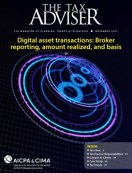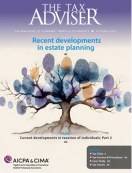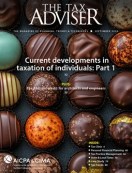- newsletter
- TAX INSIDER

IRS guidance denies ERC for most majority owners’ wages
Please note: This item is from our archives and was published in 2021. It is provided for historical reference. The content may be out of date and links may no longer function.
Related
IRS clarifies health savings account changes in H.R. 1 in new notice
Notice 2025-27 provides interim guidance on corporate AMT
IRS approves medical deduction for IVF, denies it for surrogacy
The IRS’s release of Notice 2021-49 on Aug. 4, 2021, provides employers with additional guidance on issues of the employee retention credit (ERC), including whether majority owners’ wages can be qualified wages for purposes of the credit. The new guidance clarifies that, in a majority of cases, the answer is no (see Section IV.D of the notice, “Related Individuals”).
It was already clear that the wages of individuals related to a majority owner of the employer (one who owns more than 50% of the value of an employer corporation’s outstanding stock or more than 50% of the capital and profits interests of other entities) were not eligible for the credit. Related individuals for this purpose include, under Sec. 152(d)(2):
- A child or a descendant of a child;
- A brother, sister, stepbrother, or stepsister;
- The father or mother, or an ancestor of either;
- A stepfather or stepmother;
- A niece or nephew;
- An aunt or uncle;
- A son-in-law, daughter-in-law, father-in-law, mother-in-law, brother-in-law, or sister-in-law; and
- An individual (other than an individual who at any time during the tax year was the spouse of the taxpayer) who, for the tax year of the taxpayer, has the same principal place of abode as the taxpayer and is a member of the taxpayer’s household.
(See also Section 2301(e) of the Coronavirus Aid, Relief, and Economic Security (CARES) Act, P.L. 116-136, Secs. 3134(e) and 51(i)(1), and Regs. Sec. 1.51-1(e)(1).)
These relationships are defined with reference to Sec. 51(i), which has for many years governed eligibility for the work opportunity tax credit, and Secs. 152(d)(2)(A) through (H), which define qualifying relatives as dependents and, by (partial) reference, related parties for the purpose of applying the qualified-wages rules of the ERC.
What wasn’t clear was whether the majority owner’s wages themselves were qualified. The new guidance clarifies that application of the constructive ownership rules under Sec. 267(c) severely limits eligibility of majority owners’ compensation for this purpose.
In Secs. 267(c)(2) and (4), an individual is considered to constructively own stock owned, directly or indirectly, by the individual’s family members, limited to brothers and sisters (whether by whole or half blood), plus the individual’s spouse, ancestors, and lineal descendants. Using somewhat circular logic, the IRS stated in the notice that if the majority owner of a company has a living relative with any of the relationships in Sec. 267(c)(4) (sibling, half-sibling, spouse, ancestor, or lineal descendant), then, by application of Sec. 267, that family member is a constructive majority owner to whom the direct majority owner is a related individual under Secs. 152(d)(2)(A) through (H), and the direct majority owner’s wages are not eligible for the ERC. For the direct majority owner’s spouse, if the direct majority owner has a family member under Sec. 267(c)(4) and the spouse is related to that person under Secs. 152(d)(2)(A) through (H), the spouse’s wages are not qualified wages for purposes of the ERC. Since the relationship in Sec. 152(d)(2)(G) is that of an in-law — parent, child, or sibling — in those cases, the spousal Sec. 152(d)(2) relationship will be present.
In the rare instance when the majority owner does not have any family member under Sec. 267(c)(4), then that owner’s wages may be eligible for the ERC, as are that owner’s spouse’s wages.
In the notice, Examples 1 and 4 illustrate scenarios in which majority ownership is attributed to relatives, either by direct familial attribution or by constructive ownership, resulting in ineligibility for direct majority owners’ wages as qualified wages for the ERC.
Example 1: Corporation A is owned 80% by E and 20% by F. Individual F is the child of E. Both E and F are employees of A. Pursuant to the attribution rules of Sec. 267(c), both E and F are treated as 100% owners of A. E has the relationship to F described in Sec. 152(d)(2)(C), and F has the relationship to E described in Sec. 152(d)(2)(A). Accordingly, A may not treat as qualified wages any wages paid to either E or F because both are related individuals for purposes of the ERC.
Example 4: Corporation D is owned 34% by L, 33% by M, and 33% by N. L, M, and N are siblings and employees of D. Pursuant to the attribution rules of Sec. 267(c), L, M, and N are treated as 100% owners. All three have the relationship to each other described in Sec. 152(d)(2)(B). Accordingly, D may not treat as qualified wages any wages paid to L, M, or N.
Example 2 clarifies that the eligibility of a majority owner’s wages for the credit is determined by familial ties in combination with majority ownership, not majority ownership alone, even if the relative is not employed by the company.
Example 2: Corporation B is owned 100% by G. H is the child of G. G is an employee of B, but H is not. Pursuant to the attribution rules of Sec. 267(c), H is attributed 100% ownership of B, and both G and H are treated as 100% owners. G has the relationship to H described in Sec. 152(d)(2)(C). Accordingly, B may not treat as qualified wages any wages paid to G because G is a related individual for purposes of the ERC.
Example 3 illustrates the rare instance in which the wages of the direct majority owner and spouse are eligible to be treated as qualified wages for purposes of the ERC.
Example 3: Corporation C is owned 100% by J. J is married to K, and they have no other family members as defined in Sec. 267(c)(4). J and K are both employees of C. Pursuant to the attribution rules of Sec. 267(c), K is attributed 100% ownership of A, and both J and K are treated as 100% owners. However, J and K do not have any of the relationships to each other described in Secs. 152(d)(2)(A) through (H). Accordingly, wages paid by C to J and K may be treated as qualified wages.
This guidance makes it clear that advisers must clearly understand their client’s web of familial and business relationships before applying for the credit. Owners may be deemed to have more than 50% ownership through the application of constructive ownership rules either via family members, trusts, or business relationships. Practitioners should amend previously filed credit claims if a majority owner’s compensation was included in the calculation. Unless, of course, that majority owner is a childless, orphaned only child.
— Dayna E. Roane, CPA/ABV, CGMA, is a shareholder with Perry & Roane PC in Niwot, Colo., and winner of the Lawler Award for best tax article in the JofA in 2020. To comment on this article or to suggest an idea for another article, contact Paul Bonner, senior editor, at Paul.Bonner@aicpa-cima.com.














